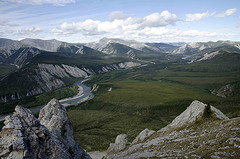Last week, the Yukon Court of Appeal heard arguments about the future of the massive Peel River watershed, and about the meaning and application of modern aboriginal treaties. Will this land be mostly protected from development, as the Planning Commission decided after extensive aboriginal consultation? Or will it mostly be used for resource extraction, as the Yukon government wants? So soon after the report of the Truth and Reconciliation Commission, will First Nations interests again be sacrificed for the economic gain of others?
Peel Watershed
The Peel Watershed is huge: 77,000 km2. It drains 14% of the Yukon, flowing into the Beaufort Sea via the Peel and then Mackenzie Rivers. While the lower part of the Peel and its confluence with the Mackenzie River are in the North West Territories, most of the watershed in the Yukon. The Yukon portion of the watershed, the Peel Watershed Planning Region (PWPR), has been undergoing land use planning, as required by Chapter 11 of the landmark Yukon Land Claims Agreement.
The PWPR is contains no communities, but is within the Traditional Territories of, and extensively utilized by, four small First Nations: The Na-cho Nyak Dun, the Tetlit Gwich’in, the Vuntut Gwitchin and the Tr’ondëk Hwëch’in. These people, along with the now gone Tukudh Gwich’in, have lived and travelled in the region for millennia; some of the earliest evidence of humanity in Canada is within Vuntut Gwitchin territory. For the Tetlit Gwich’in, the Peel is the centre of their world; the name Tetlit Gwich’in means “people who live at the head of the waters”.
The Peel watershed also contains substantial mineral resources, including the huge Crest iron ore deposit explored half a century ago. (Estimated regional geological resource 18 billion tonnes.) The multi billion dollar Crest Deposit belongs to Chevron, which wants to build roads, railways and pipelines to develop it. If Chevron pays for this infrastructure, many other resource deposits in the area will also become economic to develop.
First Nations here say no to development
The First Nations and Planning Commission cannot stop Chevron from developing its mine, but they would not permit Chevron to develop any surface infrastructure, such as roads, to get there. As a result, more than 54,000 square kilometres of wilderness would be protected from mining and other industrial development.
Who gets to decide?
The key issue is who gets to decide what should be done with this huge watershed. Under the 1990 Umbrella Final Agreement, incorporated in all the First Nations Final Agreements in Yukon, what did the First Nations get in exchange for giving up their land claims? Did they get a voice, a vote or a veto on resource development in their traditional lands? Can the Yukon government simply reject what the First Nations have to say about the exploitation of their traditional territory?
The Yukon Government claims that, as the government of the entire territory, it has the right to make land use planning and resource extraction decisions, regardless of the opinions of the handful of people who claim traditional territories there. The First Nations have been consulted, the government just doesn’t agree with their conclusion. Yukon wants and needs the roads and other infrastructure that Chevron would build, and the tax revenue they would pay. And how could the government ever afford to compensate Chevron for preventing the development of its mine?
First Nations argue that allowing Chevron to exploit their land, against their will, makes a mockery, again, of everything that was promised to them when the treaties were negotiated.
The courts
Last year, the Supreme Court of the Yukon ruled that the Yukon Government violated the land use planning process laid out in the Umbrella Final Agreement when it decided to open most of the Peel Watershed to resource extraction, notwithstanding the Planning Commission recommendations to the contrary. The Yukon Government appealed.
The facta are powerful and well worth reading. You can read the Yukon government’s Appeal factum and a summary of the Yukon Supreme Court Judge’s decision here.
Now we wait for the decision, and ultimately for the ruling of the Supreme Court of Canada. And if you want to paddle the Peel River, go now.

